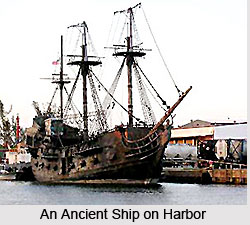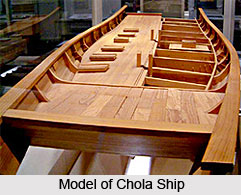 Indians of the littoral have been competent mariners for thousands of years. They first sailed in primitive rafts made from estuarine rushes, then on logs or planks bound together to form the ubiquitous Kattumaram, still in use by estuarine and off-shore fishermen along the southern peninsular coasts. Ancient ships in India thus did take off as a promising prospect, which slowly and gradually were transformed into well founded ships, double ended, which had their planks stitched together and to the ribs by yarn of coconut fibre. Iron was known, but iron nails as fasteners were forbidden because of a firm belief that the open waters of the Indian Ocean were strewn with magnetic lodestones, which would wreck the ships by pulling out the iron fasteners. This belief had served as the outcome of a treatise on shipbuilding and ships in ancient India. The book, Yuktikalpataru, had been authored by a certain Bhoja in the 6th century. It classed shipbuilding timbers according to the established social order of caste. The book was readily understood and widely accepted. According to the book, timbers could not be mixed in building of ancient Indian ships. Timbers amalgamating higher and lower castes used in the ship would lead to a weak structure. Yuktikalpataru also talked about unlucky ships and much else. This kind of irrational twaddle had the effect of making Indian Ocean-faring ships unsuited to long and stormy ocean passages. Stitched hulls were believed to make for flexible forms, which would yet be strong enough to be seaworthy. This, however, was not carried out in practice. However proof also lies in the fact that enormous ships, as heavy as 600 tons of stitched hull construction, manned by Indian crews did cross the Arabian Sea and Bay of Bengal with cargoes and passengers to destinations along opposite shores of these seas of the Indian Ocean.
Indians of the littoral have been competent mariners for thousands of years. They first sailed in primitive rafts made from estuarine rushes, then on logs or planks bound together to form the ubiquitous Kattumaram, still in use by estuarine and off-shore fishermen along the southern peninsular coasts. Ancient ships in India thus did take off as a promising prospect, which slowly and gradually were transformed into well founded ships, double ended, which had their planks stitched together and to the ribs by yarn of coconut fibre. Iron was known, but iron nails as fasteners were forbidden because of a firm belief that the open waters of the Indian Ocean were strewn with magnetic lodestones, which would wreck the ships by pulling out the iron fasteners. This belief had served as the outcome of a treatise on shipbuilding and ships in ancient India. The book, Yuktikalpataru, had been authored by a certain Bhoja in the 6th century. It classed shipbuilding timbers according to the established social order of caste. The book was readily understood and widely accepted. According to the book, timbers could not be mixed in building of ancient Indian ships. Timbers amalgamating higher and lower castes used in the ship would lead to a weak structure. Yuktikalpataru also talked about unlucky ships and much else. This kind of irrational twaddle had the effect of making Indian Ocean-faring ships unsuited to long and stormy ocean passages. Stitched hulls were believed to make for flexible forms, which would yet be strong enough to be seaworthy. This, however, was not carried out in practice. However proof also lies in the fact that enormous ships, as heavy as 600 tons of stitched hull construction, manned by Indian crews did cross the Arabian Sea and Bay of Bengal with cargoes and passengers to destinations along opposite shores of these seas of the Indian Ocean.
Ancient ships and shipbuilding in India carried on despite improvisations in the Arab or Chinese coast. Indian shipbuilders did not abandon their obsolete practices enshrined in the Yuktikalpataru, not until the arrival of the Europeans. They then readily adopted the iron nail fastener and the transom stern, in some cases, as an easier hull form to mount a rudder. The Europeans were much impressed by the competence of Indian shipbuilders and carpenters. They entrusted the building of their warships and trading vessels to Indian yards, established especially for the purpose. The outcome became such a conspicuous affair of success as to cause disquiet among their homebuilders. Many of the ancient Indian-built ships became famous in history for their sturdy build and longevity, as Indian teak was superior to European oak. Many of the old and legendary hull forms were still being built for Indian and Gulf owners. There existed the double-ended Kotias in Cuddalore and Mangalore, also in Kutch, the famous Thoni in Tuticorin, transom stern Baggalas in Mandvi, Machwas in and around Bombay waters and many other interesting local forms. Palk Bay was a strategic dock where the vessels were busy in local trade within the Bay.
Indian migration and colonisation across the Bay of Bengal immediately before and during the early years of the Christian era were significant times in ships built in ancient India. There is a perplexing and as yet unresolved dichotomy in the maritime traditions of the Indian people. The fear of the sea, prejudices against crossing it and yet the undeniable fact that large numbers crossed the Bay of Bengal in search of a better life. The complexity now arises because of a lack of historical record pertaining to Indian activities around the Indian Ocean.
 Information from Roman and later Arab sources informs in clear terms of the great trading emporia Muziris (near today`s Kodungallur or Cranganore), Gokarn Cheul, Sopara Prabhaspatan (near today`s Somnath. Trading ships of various types and sizes were built along the coasts and equipped for prolonged ocean voyages. Merchants crossed the ocean regularly with their goods to ports along the littoral and then for trans-shipment to the Mediterranean empires. In present times, shipbuilding skills of the shipbuilders of Beypore (Calicut) and Tuttukudi (Tuticorin) attract ship owners from the Gulf and Red Sea as well, of course, from India. Navigation and seamanship expertise of Indian sailors must have been of adequate sophistication to convey their ships safely across the ocean on voyages of 3000 nautical miles or more. This bravely bears proof of ancient ships in India being built keeping in mind long-term future prospects. Knowledge of traditional nautical astronomy, navigation and instruments remain dear very much to coastal Indians. They are still used by nakhodas or sailing vessels, which ply the west coast of India East Africa, the Hadramaut and the Persian Gulf. There however rests ther fact of the reluctance of caste Hindus to crossing the sea frontier of the subcontinent. The evidence of sea friendly civilizations of Mohenjodaro and Harappa is not wanting; the dock at Lothal is one of it. The tribes and people who encroached into Hindustan were, arguably, not as good seamen and sailors as the Indus Valley people. There are, however, pretty significant references to navigational activities in the Rig Veda, as for example, words `Samudra`, `Nav` etc. Later literature of the Shatapatha Brahmana, the Ramayana, the Mahabharata, Manusmriti, the Puranas serve ample proof of the maritime inclinations of the Aryans. There is this line in the Mantra Pushpanjali, which invokes `Prithivyai Samudra Paryantayah Ekarakiti` standing for: `Let our writ run across this ocean-girt Earth`.
Information from Roman and later Arab sources informs in clear terms of the great trading emporia Muziris (near today`s Kodungallur or Cranganore), Gokarn Cheul, Sopara Prabhaspatan (near today`s Somnath. Trading ships of various types and sizes were built along the coasts and equipped for prolonged ocean voyages. Merchants crossed the ocean regularly with their goods to ports along the littoral and then for trans-shipment to the Mediterranean empires. In present times, shipbuilding skills of the shipbuilders of Beypore (Calicut) and Tuttukudi (Tuticorin) attract ship owners from the Gulf and Red Sea as well, of course, from India. Navigation and seamanship expertise of Indian sailors must have been of adequate sophistication to convey their ships safely across the ocean on voyages of 3000 nautical miles or more. This bravely bears proof of ancient ships in India being built keeping in mind long-term future prospects. Knowledge of traditional nautical astronomy, navigation and instruments remain dear very much to coastal Indians. They are still used by nakhodas or sailing vessels, which ply the west coast of India East Africa, the Hadramaut and the Persian Gulf. There however rests ther fact of the reluctance of caste Hindus to crossing the sea frontier of the subcontinent. The evidence of sea friendly civilizations of Mohenjodaro and Harappa is not wanting; the dock at Lothal is one of it. The tribes and people who encroached into Hindustan were, arguably, not as good seamen and sailors as the Indus Valley people. There are, however, pretty significant references to navigational activities in the Rig Veda, as for example, words `Samudra`, `Nav` etc. Later literature of the Shatapatha Brahmana, the Ramayana, the Mahabharata, Manusmriti, the Puranas serve ample proof of the maritime inclinations of the Aryans. There is this line in the Mantra Pushpanjali, which invokes `Prithivyai Samudra Paryantayah Ekarakiti` standing for: `Let our writ run across this ocean-girt Earth`.
In the Arthashastra, Kautilya codifies the entire spectrum of a state`s maritime concerns and activities. The Admiralty is the nodal office under the Navadhyaksha, the superintendent of ships. The Buddhist Jatakas are full of interesting accounts of Indian maritime activities. The Baveru Jataka describes the adventures of some Indian merchants who, for the first time, conveyed peacocks to Babylon by sea. The Tamil people were also comfortable with the sea. They were among the leading traders with Babylon. On the east coast, the Kalingas, the Cholas and the Andhras were equally active at sea. Such excellence can only happen at sea when the vessels they are ferrying in are sturdily constructed. Ancient ships in India thus were absolutely made under serious motives, in presence of scholarly men. There is a tradition in Orissa, inherited from the old kingdom of Kalinga, which takes thousands of local celebrants to the coasts on Dassera day between Puri and Balasore. There they float tens of thousands oil lamps in paper boats on the water to commemorate the days when great convoys of ships set out each year on Dassera day, towards Suvarnabhoomi. In many lands of Southeast Asia, Indians are still known as Kalings.
During the British period in India, ancient shipbuilding took a dramatic turn, in which the `white men` encouraged shipbuilding in Bombay. This was perhaps because they were by that time firmly established in India and were ready to meet the needs of the East India Company and of the Royal Navy. Later, with the arrival of steam and iron in place of sail and timber, they were equally prompt to suppress the Bombay enterprise, lest it competed with the shipbuilders at home.



















